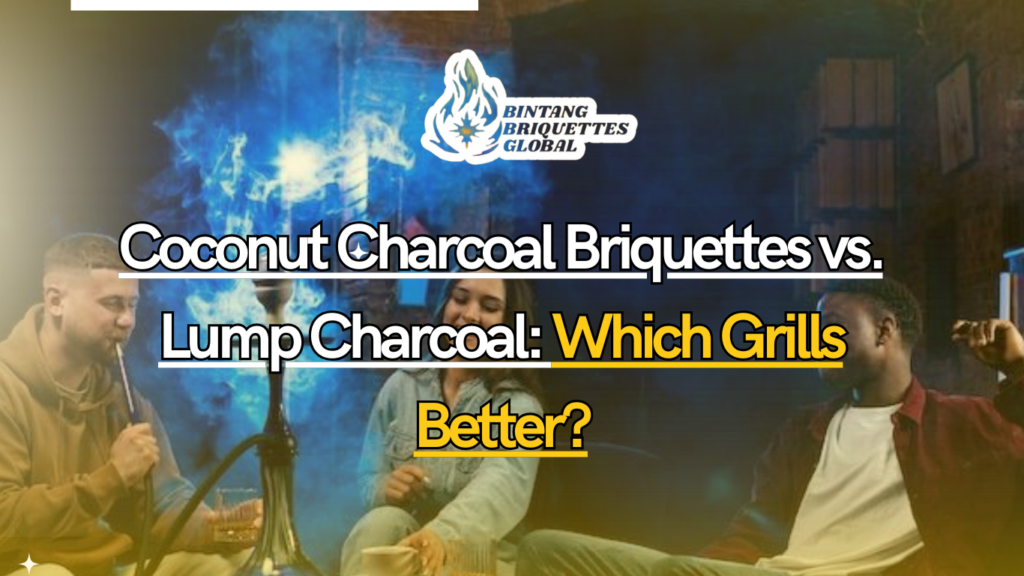1. Introduction
bintangbriquettes.com – When it comes to grilling, choosing between coconut charcoal briquettes vs. lump charcoal is one of the most debated topics among pitmasters and home BBQ enthusiasts seeking the perfect grilling experience.
In this article, we’ll explore the detailed differences between coconut charcoal briquettes and lump charcoal, diving into their composition, performance, environmental impact, and more to help you decide: Which grills better?
2. What Are Coconut Charcoal Briquettes?
Coconut charcoal briquettes are manufactured from coconut shell waste, a by-product of the coconut industry. These briquettes are made by carbonizing the shells and compressing the charcoal powder with a natural binder, typically tapioca starch. The result is a uniform, cube-like piece of charcoal that is clean, smokeless, and ideal for controlled grilling environments.
Advantages:
- Sustainable and eco-friendly
- Long burning time
- Uniform size and shape
- Low ash production
3. What Is Lump Charcoal?
Lump charcoal, often referred to as natural hardwood charcoal, is made by burning hardwood (like oak, hickory, or mesquite) in a low-oxygen environment. The process removes moisture and volatile compounds, leaving behind pure carbon.
Advantages:
- Burns hotter
- Imparts natural wood flavor
- Lights quickly
However, lump charcoal can vary in shape and size, and burns faster than briquettes, requiring more frequent refueling.
4. Production Process: Coconut Charcoal Briquettes vs. Lump Charcoal
Coconut Charcoal Briquettes:
- Made from agricultural waste (coconut shells)
- Requires carbonization and compression
- Use of binders (natural starch)
Lump Charcoal:
- Made from chunks of hardwood
- Charred in kilns with minimal processing
- No binders; purely carbonized wood
This difference in production also impacts sustainability. Coconut charcoal briquettes are made from renewable waste, while lump charcoal requires cutting trees unless reclaimed wood is used.
5. Heat Efficiency and Burn Time Comparison
Coconut Charcoal Briquettes:
- Burn time: 2–3 hours consistently
- Heat level: Medium to high (700–800°F)
- Suitable for long grills or indirect cooking
Lump Charcoal:
- Burn time: 45 minutes – 1.5 hours
- Heat level: Very high (up to 1000°F)
- Ideal for high-heat searing
Conclusion: Coconut charcoal briquettes win in terms of burn duration and steady heat, making them ideal for smoking and long barbecue sessions.
6. Ash Production and Clean-Up
Ash quantity plays a crucial role in determining cleanliness and air flow.
- Coconut Charcoal Briquettes: Produce very little ash (less than 5%), making clean-up easier and promoting better airflow.
- Lump Charcoal: Produces more ash depending on the wood type and burn rate.
If minimal ash and less frequent cleaning are important to you, coconut charcoal briquettes are the better option.
7. Environmental Impact
Coconut Charcoal Briquettes:
- Made from waste material (coconut shells)
- No tree-cutting involved
- Lower carbon emissions during production
Lump Charcoal:
- Involves cutting hardwood trees
- Higher carbon footprint
- Some production involves deforestation
Coconut charcoal briquettes are a greener and more sustainable solution, especially for environmentally conscious consumers.
8. Flavor Influence in Grilling
Flavor is a big factor in choosing charcoal.
- Lump Charcoal: Known for giving meats a smoky, woody flavor depending on the hardwood used.
- Coconut Charcoal Briquettes: Virtually odorless and tasteless, giving chefs full control over flavor through marinades and woods.
If you want a neutral grilling base, go with coconut. If you like natural smoky undertones, lump charcoal is the winner.
9. Availability and Cost
Coconut Charcoal Briquettes:
- Widely available in export markets like the Middle East, Europe, and the U.S.
- More consistent in shape and size
- Generally more affordable in bulk
Lump Charcoal:
- Widely available in retail stores
- Price can fluctuate depending on wood source
- Larger bags often contain unusable small pieces
10. Ease of Use for Beginners
- Coconut Briquettes: Easier to light with consistent heat and burn time. Best for beginners or low-maintenance BBQs.
- Lump Charcoal: Requires more skill to manage airflow and temperature. Best for experienced grillers.
For effortless grilling, coconut briquettes are recommended.
11. Storage and Shelf Life
- Coconut Charcoal Briquettes: Moisture-resistant when stored properly. Long shelf life due to low volatile compounds.
- Lump Charcoal: Absorbs moisture easily; can be harder to relight after storage.
Briquettes are easier to store, especially in humid climates.
12. Safety Considerations
Coconut briquettes:
- Burn consistently without flare-ups.
- Less chance of sparks or sudden flames.
Lump charcoal:
- Can cause flare-ups due to inconsistent pieces.
- Higher risk of sparking and uneven heat.
For safe, controlled grilling, coconut charcoal briquettes are safer.
13. Expert and Chef Opinions
Many grill masters recommend using coconut charcoal briquettes for:
- Low and slow cooking
- Professional kitchens
- Hookah and shisha lounges
Lump charcoal is favored by:
- Outdoor BBQ experts
- Those wanting bold flavor
- High-temperature steak grilling
14. Regional Preferences and Market Trends
- Middle East & Europe: High demand for coconut charcoal due to cleaner burn and sustainability.
- U.S. & Australia: Split preference—backyard grillers use lump charcoal; professionals are shifting toward coconut charcoal.
15. Final Verdict: Which One Grills Better?
So, which grills better?
- For long-lasting heat, clean burns, sustainability, and beginner-friendly use — Coconut Charcoal Briquettes win.
- For short bursts of intense heat and smoky flavor — Lump Charcoal is preferred.
Ultimately, it depends on your grilling style. Want steady heat and easy clean-up? Go coconut. Want intense, smoky sears? Go lump.
16. Frequently Asked Questions
Q: Are coconut briquettes safe for grilling?
Yes. They are non-toxic and burn cleanly with minimal smoke.
Q: Do coconut briquettes affect food flavor?
No. They are odorless and allow the food’s seasoning to stand out.
Q: Can I use lump charcoal in a ceramic grill?
Yes, but monitor temperature closely due to high heat.
17. Conclusion
The debate of Coconut Charcoal Briquettes vs. Lump Charcoal doesn’t have a single answer. It’s about what suits your grilling needs.
Choose coconut charcoal briquettes if you value:
- Consistent burn
- Eco-friendliness
- Low ash
Go for lump charcoal if you prefer:
- Quick heat-up
- Natural wood flavor
- Traditional grilling experience
In the end, the right charcoal helps you grill better, faster, and tastier.
Ready to Start?
At Bintang Briquettes, we specialize in Private Label Shisha Charcoal Manufacturing in Indonesia. We offer:
- Premium coconut charcoal
- Full custom packaging
- Fast shipping
- Reliable quality
📧 Contact us at: sales@bintangbriquettes.com
📞 WhatsApp: +62 859-3481-2012
🌐 Website: www.bintangbriquettes.com
Let’s build your shisha brand together.

